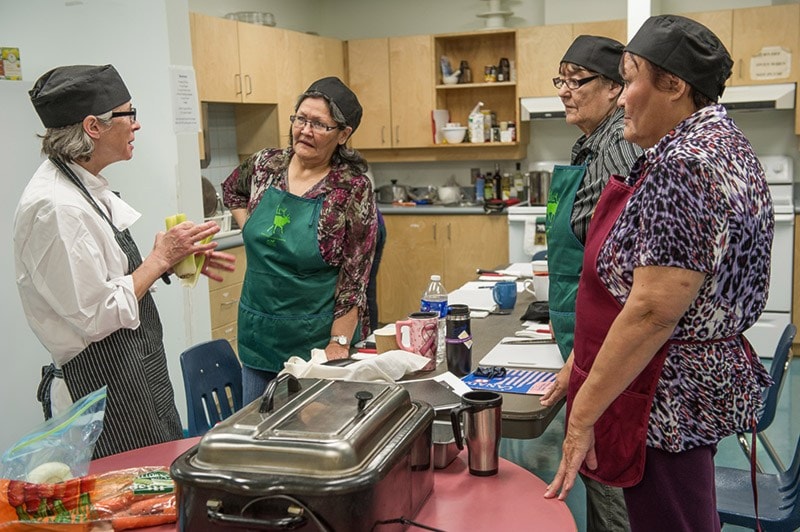Skinning and cooking a caribou head might seem like a daunting task, even for experienced cooks. After all, how often do Yukoners have a chance to eat morel mushroom caribou brain ravioli?
But a new cookbook by Yukon chef Miche Genest, writer and producer Kelly Milner, photographer Cathie Archbould and the Vuntut Gwitchin First Nation aims to teach Yukoners how to use every part of the caribou.
The idea behind Vadzaih: Cooking Caribou from Antler to Hoof came together after the Porcupine Caribou Management Board became concerned about meat waste.
Some hunters, they learned, were not using certain parts of the caribou — “vadzaih” in Gwitchin — like the head, kidneys or liver.
“Some people simply didn’t know what to do with some parts of the animal,” said Milner. “This is really meant to be a positive way of looking at encouraging people on how to use all the parts and respect the caribou.”
During the fall of 2015, Milner, Genest and Archbould flew to Old Crow for a workshop with six local cooks. They learned traditional recipes and exchanged new recipes, blending the flavour of caribou meat with those of other food cultures.
Alongside recipes for traditional caribou bone broth, readers will find recipes for caribou wonton soup, caribou heart tortillas and caribou French onion soup.
The local cooks loved the new recipes, Genest said.
“When we were making the wonton soup, one of the ladies said, ‘I’m going to make it for my granddaughter,’” Genest said.
When crafting the recipes, Genest first took a look at what the Old Crow grocery store had available to make sure it would be feasible for residents of Northern communities.
Using every part of the animal is something most cultures share, Genest said. But the fast industrialization of food production over the past 25 years made cheap meat ubiquitous, and those traditional recipes and practices have been fading away.
“We used to do it because it was economical and it was prudent,” Genest said. “As a kid, my mom and dad had often ate liver and had lamb kidneys for breakfast.”
The brain ravioli, by the way, was a huge hit, Milner said.
To get to the brain, once you’ve skinned the head, you take an axe or a saw and cut off the top of the skull “and the brain comes right out,” said Milner.
“Is it as awesome as you think it would be? Yeah.”
Local cook Bertha Frost made her famous head cheese. As the head is slow cooked for a long time, meat falls off and is mixed with gelatin to form a pâté.
Nothing goes to waste, Frost told the News. Caribou bones are used for bone broth and can be reused several times.
“We drink the broth when we’re not feeling good,” Frost said. “It’s like medicine.”
Elizabeth Kaye taught the group how to roast a caribou head the traditional way. From that, Genest created a second recipe: roasted caribou head, Italian style.
The book teaches how to make delicious food, but it’s first and foremost about respect, Milner said.
“The users of the porcupine caribou herd — the Gwitchin and the Inuvialuit — they’ve relied on this herd for generations,” she said. “They want to see that herd persist for generations to come and if that’s going to happen, we have to value, respect (the animals).”
Learning to prepare all the parts of the caribou can be difficult at first. Genest remembers when Joe Tetlichi, the chair of the Porcupine Caribou Management Board, showed her how to skin and clean a caribou head.
He then left her to finish cleaning the head.
“I was trying to clean the hairs but I was just making it worse,” Genest said. “That was a really moment of despair, I thought, ‘how I can pretend to be a chef when I can’t even clean the hair off a caribou head?’”
Eventually, she figured if she soaked the head, it would make it easier to cut all the hair.
“Any tricky project, once you get into it it’s fine,” she said. “It’s really interesting and fun to tackle something that much out of your comfort zone.”
Caribou heart for example, proved to be a particularly good cut once cleaned.
“It’s not an organ, it’s a muscle, you should think of it as lean steak,” Genest said. “As with other steaks, especially wild meat, the best way to cook it is hot and fast, not very long so it’s still somewhat rare inside.”
The book doesn’t just provide recipes for making traditional and contemporary with caribou. It also has a step-by-step guide on how to prepare the different parts of the animal, and a field dressing guide for hunters.
Milner pointed out that having a photographer like Archbould on the project made a huge difference: photos of each cut are more helpful when learning about the caribou than diagrams. Archbould also captured the local cooks while they were preparing food in their own kitchens.
The cookbook also has a small section with recipes for sweets and fresh drinks, the idea being to provide all the recipes needed to have a community feast, Genest said.
Vadzaih: Cooking Caribou from Antler to Hoof is available for sale at Mac’s Fireweed books, at the John Tizya Centre in Old Crow, or by contacting the Porcupine Caribou Management Board at www.pcmb.ca.
Contact Pierre Chauvin at pierre.chauvin@yukon-news.com
